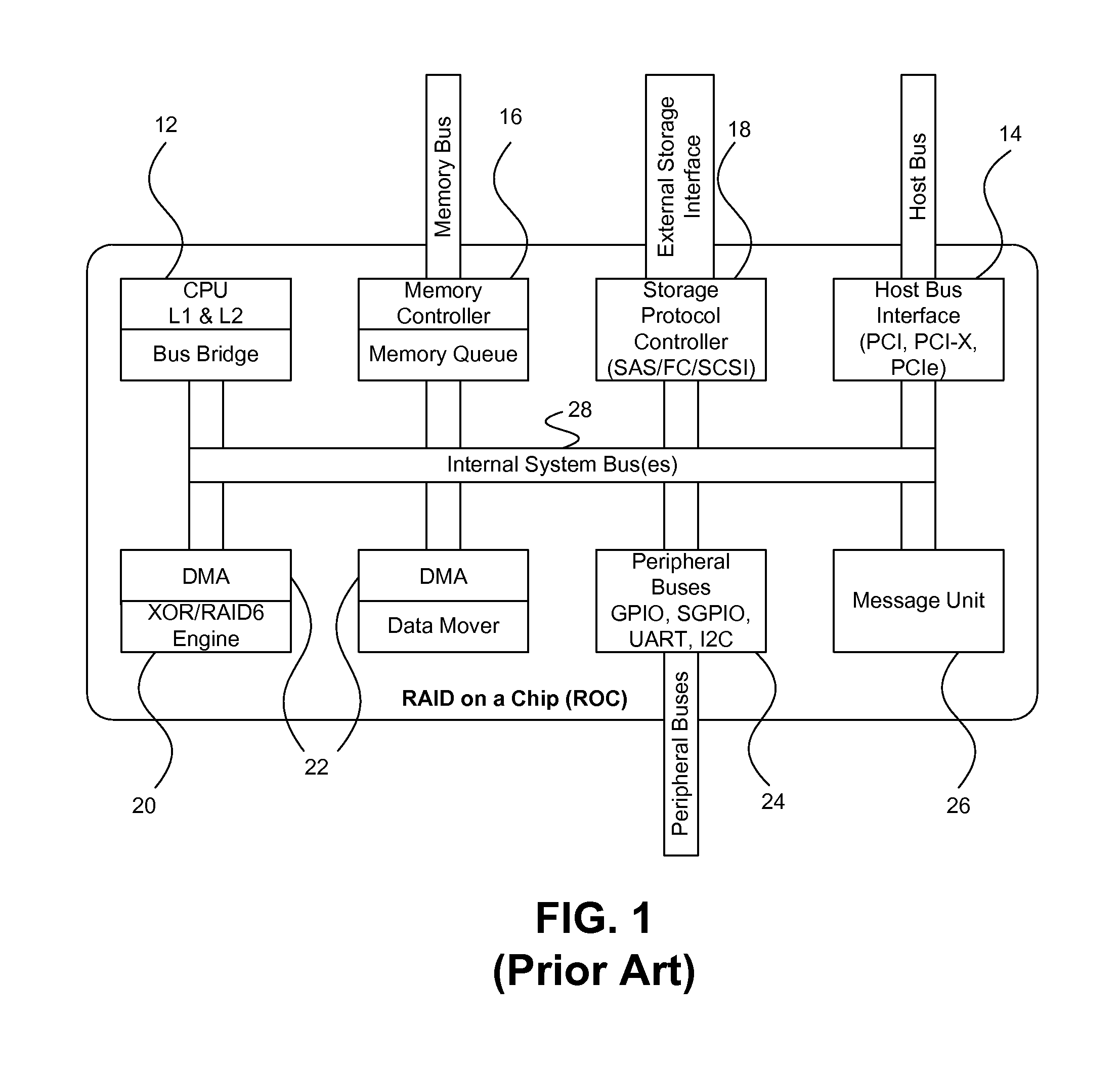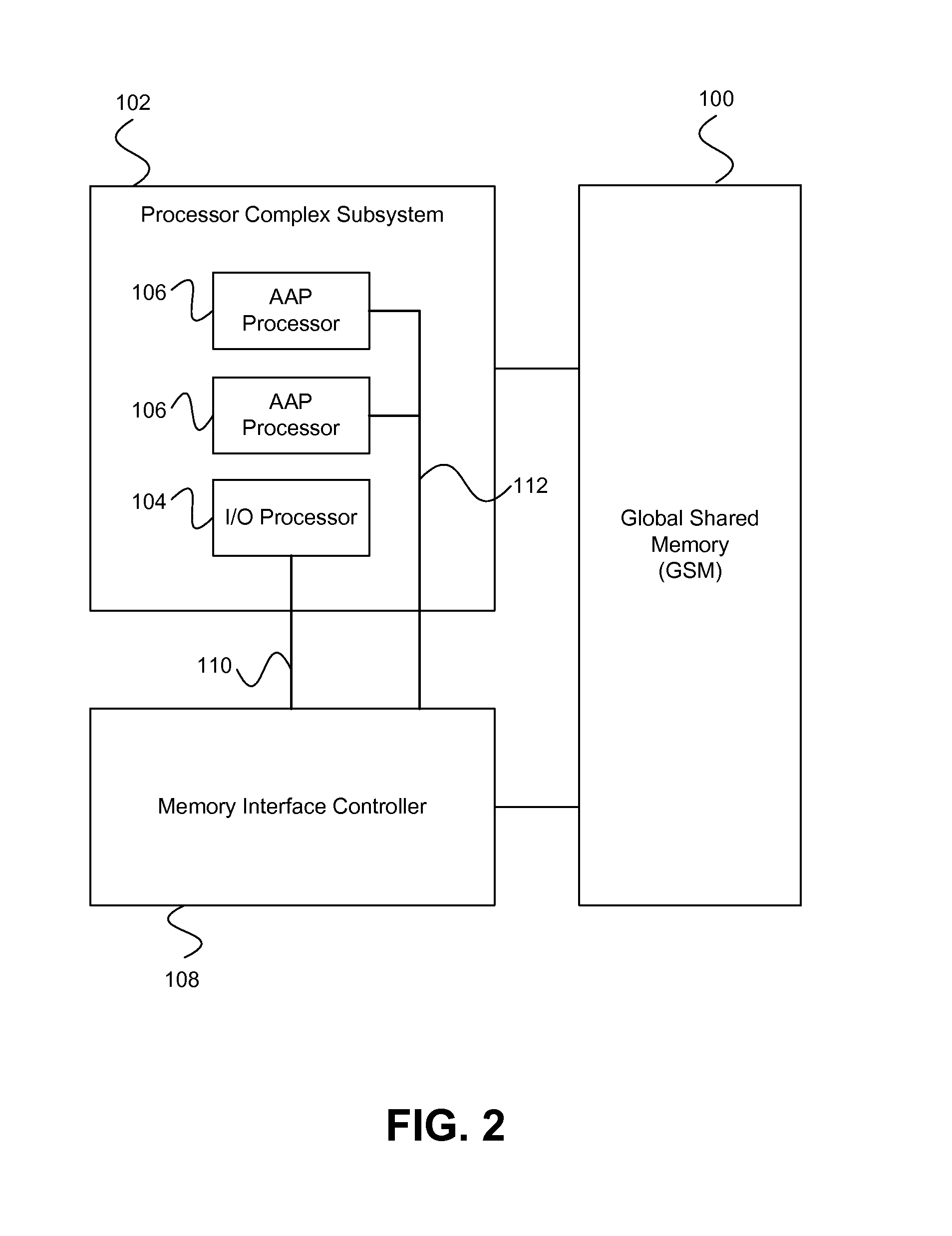Because many of the data structures and control structures are quite complex and significant in size, typically they are stored in DDR or PCI memory space.
The architecture of FIG. 1 has difficulties scaling towards higher RAID
system performance requirements, as the speed of interfaces increases according to new protocol standards such as SAS-2 and PCIe Gen2. The main limitations include:
1. Lack of multi-processor support, which limits the RAID stack
firmware performance as CPU cycles become saturated.
2. Even when multiple processors are added to the ROC architecture, the CPU performance is still hampered by fabric contention as they compete for access for DDR or other common resources.
4.
Bus fabric typically causes Head of Line (HOL) blocking issues on concurrent transfers over different physical interfaces.
If the DMA master faces a temporary contention on DDR, this causes subsequent transfers, which request data from PCI, to be blocked even though the
PCI interface is completely idle in the mean time.
This often leads to distributed small local buffer memory that is required by each subsystem.
The distributed buffer results in low memory utilization, low memory density (due to the small size of each buffer RAM), and large overhead for logic that handles the DFT (Design For
Testability), ECC, and lack of flexibility for sharing of buffer resources across the
local function block boundaries.
Given that the
DRAM bandwidth available to a ROC device is limited by the current state of the art of the
DRAM technology, i.e. the width of the
memory bus that is dictated by the cost point of the ROC solution, it is impractical to increase
DRAM bandwidth beyond a certain established threshold at given design constraints.
Hence the memory
bottleneck becomes the ultimate
limiter of scaling ROC system performance.
7. A further limitation of the off-
chip memory oriented
processing by the hardware engines is the lack of support of multi-pass
processing of data.
This results in data movement on and off-chip multiple times, consuming the critical
memory bandwidth resource.
The net result is lower system performance and
higher power consumption for a given processor / memory speed.
8. A further common characteristic of the conventional ROC architecture is the lack of centralized DMA service that provides the data movement, address translation (such as handling of scatter-gather), and management of context switching (on transfers that involves part of a partial scatter gather buffer).
This distributed DMA approach has the following shortcomings:
a. Repeated logic leads to greater gatecount and higher cost of the ROC system. In particular, the complexity of handling address-translation (scatter-gather) and the context saving / switching for partial scatter-gather buffer handling is repeated in each hardware subsystem that requires DMA function. The logic for handling of mis-aligned addresses,
paging of data in and
out of memory,
endianness conversion etc is repeated. Any bug fixes in one subsystem may or may not be propagated to other subsystem's DMAs that have a similar design.
b. Distributed DMAs compete for access to external memory interfaces autonomously, leading to inefficient usage and sometimes unfair sharing of external memory bandwidth.
c. The distributed DMA approach often leads to divergences in the DMA features mentioned in a) over time of evolution of the design, resulting in inconsistency in
programming interfaces for the various hardware engines, and results in difficulty in maintaining the hardware and software
source code.
Distributed DMAs often require arbitration in the internal fabric, which leads to higher latency, and larger overhead for accessing external interfaces.
This often leads to lower performance, and higher cost of buffering.
The lack of virtual address DMA seriously complicates the design of the DMA master, particularly in the handling of context saving / switching among partial transfers.
1. To scale up the raw CPU processing speed as represented by the number of instructions the ROC device can execute per second. Since the speeds of storage interfaces and PCI
bus interfaces are accelerating at a faster rate than the increase in CPU processing speed offered by Moore's Law in recent years, a single embedded processor can no longer keep pace with the requirement of RAID processing. Consequently, the ROC architecture should support multiple processors on-chip.
3. To provide efficient & uniform DMA structure that presents a consistent representation of DMA operation and scatter / gather buffer definition that is capable of handling a large number of concurrent buffers and fast context switching among partial buffer transfers. Ideally the DMA operation should be consistent no matter which type of hardware and software acceleration / operation functions are applied to the data. The DMA also should be able to be non-blocking in order to fully utilize the
bus bandwidth on system buses, storage interfaces, and on-chip and off-chip memory interfaces.
4. The ROC architecture should minimize the
data traffic moving across external interfaces, specifically the off-chip memory interfaces, to resolve system performance
bottleneck on memory bandwidth.
5. To have efficient on-chip system interconnect for the CPUs and the hardware engines, the DMAs should allow all processing engines and
firmware programs to execute concurrently without blocking each other while competing for access for the system interconnect.
6. To support RAID processing without using an external DRAM interface. Ideally this can be done without significantly changing the
software architecture of the RAID stack. This should be achieved either with on-chip memory resources or
host memory resource in the PCI space.
7. To support multi-pass processing, wherein the data is processed by multiple hardware and / or
firmware entities with flexibility on the type of operations applied without transferring the intermediate results off-chip and on-chip again between the processing steps, the sequence of the operation, and the capability of
context switch amongst partial
data processing that are associated with independent processing threads or I / O processes.
 Login to View More
Login to View More  Login to View More
Login to View More 


